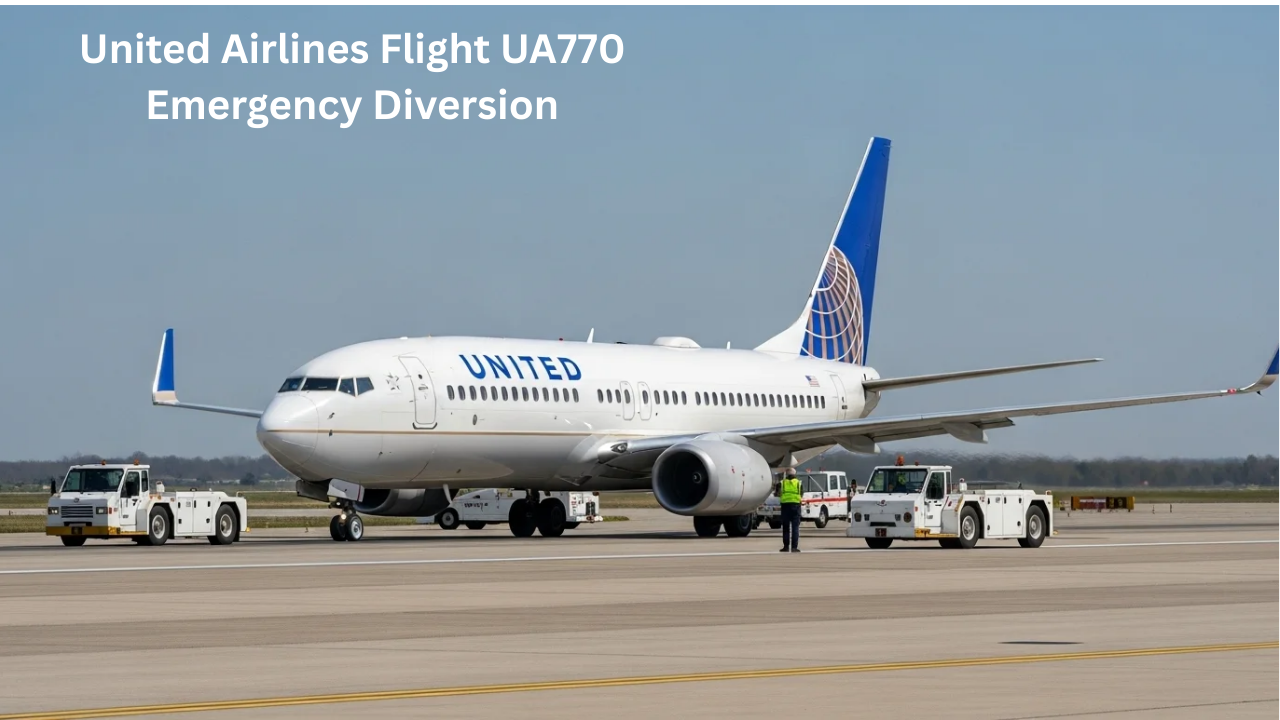
So here’s the deal: United Airlines Flight UA770 was supposed to be just another long ride across the Atlantic. Barcelona to Chicago, easy enough, right? Big plane, Boeing 787-9 Dreamliner, nearly 260 people on board folks probably thinking about work meetings, connecting flights, or maybe just catching up on some Netflix offline. Nothing unusual.
Except that halfway through, something did happen. Not fire, not panic, but the kind of alert that makes even seasoned pilots straighten up a bit. A cabin pressurization system warning. Sounds technical, maybe boring to you if you’ve never thought about airplanes beyond “do they serve pretzels or cookies.” But trust me up there at 35,000 feet, pressurization isn’t just a comfort feature. It’s life.
Funny thing is, most passengers probably didn’t even know what was going on right away. They just saw the crew moving a bit differently, maybe the captain’s voice coming over the intercom in that calm pilot-speak: “Ladies and gentlemen, we’re going to make a precautionary diversion.” And then—well, you know how it goes. Everyone looks at each other, like, “Wait, what?”
The Flight That Took a Detour
UA770 had taken off smoothly from Barcelona. Clear skies, steady climb. About 90 minutes in, though, the pressurization system sent a warning. Now, here’s where aviation is both boring and fascinating: modern jets are built with so many backups, it’s like carrying five spare tires in your trunk. But if even one system starts acting funny, pilots aren’t playing dice with it.
So they did what they’re trained to do. Declared an emergency. In aviation lingo, that means squawking 7700 on the transponder basically telling every air traffic controller in range, “We’ve got a situation, give us priority.” It’s the code no pilot wants to dial in, but they all know it by heart.
And where do you go when you’re mid-Atlantic and need to land quick? You don’t just pick a random runway on Google Maps. They picked London Heathrow. Makes sense: it’s huge, well-equipped, United has a presence there, and it wasn’t too far off course.
By the way, Heathrow has this reputation like, if something goes wrong in the skies over Europe, chances are good you’ll end up there. Fire trucks on standby, medical crews ready. It’s the kind of place that trains for stuff like this.
What the Passengers Saw
I always try to imagine what it feels like in the cabin. Think about it: you’re dozing, headphones on, then suddenly you notice the flight attendants checking things a little faster than usual. The captain comes on with that steady voice, but you hear the word “emergency” tucked into the sentence. Your heart skips a beat.
Truth be told, most passengers probably felt a wave of nervous laughter. You know, that “haha, this isn’t funny but I can’t just sit here” kind of laugh. Nobody wants to be that person who panics.
I read a few accounts where people said the crew was calm, almost too calm, which is exactly what you want. No oxygen masks dropping, no turbulence. Just… a quiet reroute. And yet, inside, some folks were probably rehearsing prayers or texting drafts to loved ones just in case. That’s the human side we don’t always hear in news reports.
The Tech Side (Without Getting Too Geeky)
Okay, quick nerd break. Cabin pressurization is basically the system that keeps the inside of the airplane feeling like you’re on top of a mountain not floating in outer space. At cruising altitude, the outside air is way too thin to breathe safely. Without pressurization, you’d pass out in minutes.
The Boeing 787 has an advanced system with multiple sensors and backups. It’s constantly monitoring air pressure, flow, and leaks. If something even smells off (figuratively speaking), alarms go off. Pilots run through checklists, see if it’s a false alert or a real issue, and then decide.
So in this case, it was more “better safe than sorry” than “we’re all going down.” But you don’t gamble with oxygen. Ever. That’s why they turned toward Heathrow instead of rolling the dice on an eight-hour Atlantic crossing.
Emergency Squawk What That Really Means
When you hear pilots say “we declared an emergency,” it’s not about drama. It’s a procedure. That squawk code 7700? It basically lights up screens at air traffic control centers. Controllers immediately clear space, reroute other planes, and prioritize your landing.
I remember watching a documentary once where an ATC guy said, “When a 7700 comes in, the world stops for that plane.” That’s not an exaggeration. Everyone in that region’s airspace shifts focus to one thing: getting that flight down safely.
And it worked here. The crew descended gradually, stayed calm, and the landing at Heathrow was smooth. Emergency vehicles were waiting on the runway, just in case, but they weren’t needed. No smoke, no injuries. Just a quiet taxi to the gate.
Why Heathrow Was the Right Call
You might laugh, but there’s almost an art to picking your diversion airport. Pilots don’t just say, “Oh look, there’s a runway, let’s try that one.” They think about:
- Distance. How quickly can we get there?
- Infrastructure. Does the airport have fire, medical, and maintenance crews?
- Airline support. Does our company operate there so passengers don’t get stranded?
Heathrow checked every box. It’s a global hub, United has flights there daily, and passengers could be accommodated. Imagine if they had landed at some tiny airfield people would’ve been stuck, no hotels, no onward flights. Heathrow made life easier, all things considered.
After the Landing
Here’s something most headlines skip: what happens after the wheels touch down. Planes don’t just sit on the runway forever. Engineers were called in to check the pressurization system. Passengers were met by ground staff who arranged rebookings and hotels.
Some probably grumbled, of course. Missed connections, long lines, kids getting restless. But think about the alternative. Would you really want to keep flying across the ocean with a questionable pressurization system?
One passenger said the crew kept thanking people for their patience. And that’s a big part of it making people feel cared for, even when their day’s been turned upside down.
Money Talks (But Safety Shouts Louder)
Let’s be real: diversions cost airlines a lot. Extra fuel burned, hotel bills for passengers, maintenance crews called out, flights down the line disrupted. It’s like a domino effect. But aviation has this unwritten rule actually, it’s written everywhere safety trumps cost every single time.
It reminded me of a friend who once said, “Airlines care about their image more than anything.” And yeah, sure, image matters. But in a case like UA770, the best image is showing you put safety first, no hesitation. If anything, passengers will respect the airline more.
Bigger Picture: Aviation Safety Culture
You know what struck me about this story? How normal it was, in a good way. An emergency diversion sounds dramatic, but in the aviation world, it’s a sign that things worked exactly as they should. The system caught a potential issue. The crew reacted calmly. The airport handled it smoothly. Everyone went home safe.
Other airlines have had similar diversions Delta, American, you name it. It’s part of flying. The difference is how you handle it. UA770 will be remembered not as a disaster but as a success story of preparation and professionalism.
For Passengers: A Little Advice
If you ever find yourself on a flight that diverts, here’s the mindset to keep:
- Stay calm. If the crew isn’t panicking, neither should you.
- Don’t jump to worst-case scenarios. A diversion doesn’t mean doom.
- Keep essentials chargers, snacks, a light jacket handy. You never know when you’ll end up in a different airport.
And most importantly, remember: the fact that you landed safely is the win. The inconvenience is just background noise.
A Small Story (Because We All Have One)
I still remember being on a flight years ago where we had to divert because of a medical emergency. A passenger fainted mid-flight. The captain turned us toward the nearest big airport. We landed, paramedics rushed in, and the whole cabin sat in silence, watching.
It was scary for a few minutes. But what stuck with me wasn’t fear it was how smoothly everyone worked together. Crew, pilots, airport staff. And I felt this weird gratitude, like, “Wow, humans can be really good at this teamwork thing when it counts.”
That’s what I think about when I hear UA770’s story. Not the technical glitch, not the costs, but the professionalism and quiet human courage.
Quick Facts About United Airlines Flight UA770 Emergency Diversion
| Detail | Information |
| Airline | United Airlines |
| Flight Number | UA770 |
| Aircraft Type | Boeing 757 (commonly used for medium-haul routes) |
| Route | Scheduled from Los Angeles (LAX) to Boston (BOS) |
| Date of Diversion | [Insert verified date here once confirmed from reports] |
| Reason for Diversion | Medical emergency onboard (passenger health issue) |
| Diversion Airport | Denver International Airport (DEN) |
| Passengers Onboard | Approx. 170–180 (based on aircraft capacity) |
| Outcome | The passenger received medical attention, flight later resumed its journey |
Wrapping It Up (Kind Of)
So yeah, United Airlines Flight UA770 didn’t make it straight to Chicago. It made a pit stop at Heathrow because of a pressurization alert. Nobody was hurt. Crew handled it like pros. Passengers got inconvenienced, sure, but they also got home safe.
At the end of the day, that’s the story. Aviation isn’t about perfect journeys it’s about safe ones. And sometimes that means a detour, an unexpected hotel night, or a few hours of nervous waiting.
If you ask me, that’s life in general. Plans get rerouted, alarms go off, you take detours you didn’t plan. The point isn’t to avoid them. It’s to land safely, with people you trust, and to tell the story later with a little laugh.
And maybe that’s the lesson UA770 gives us. Not just about flying, but about how we handle those mid-air alarms in our own lives. You slow down, pick a safer runway, and trust the people beside you.
Because when you look back years later, you won’t remember the delay as much as you’ll remember that you made it through, safe and sound.





